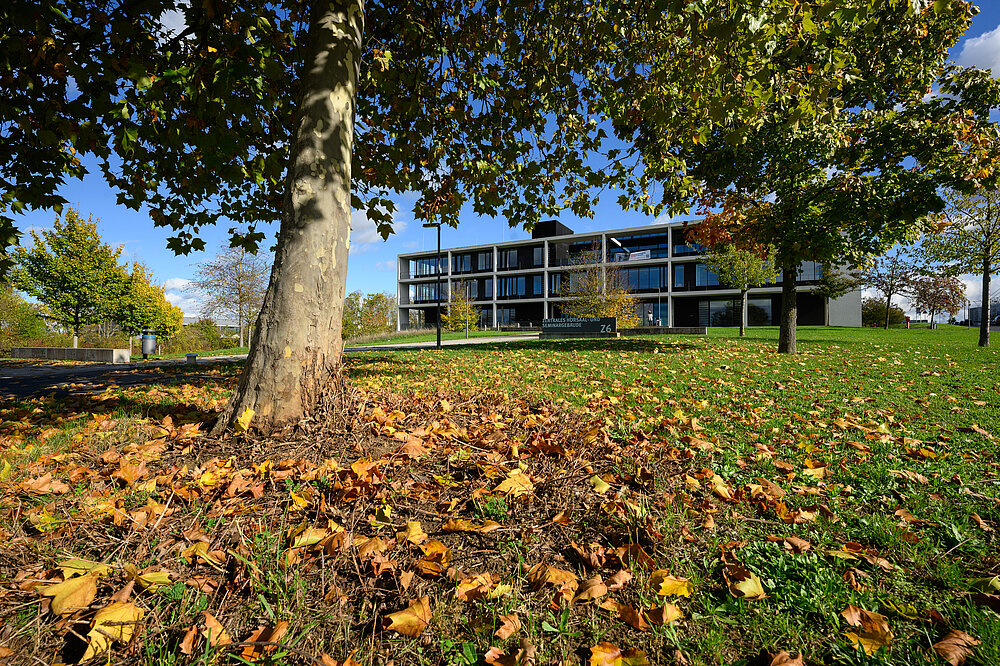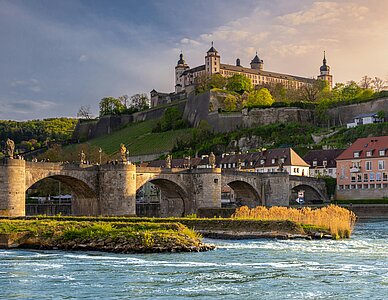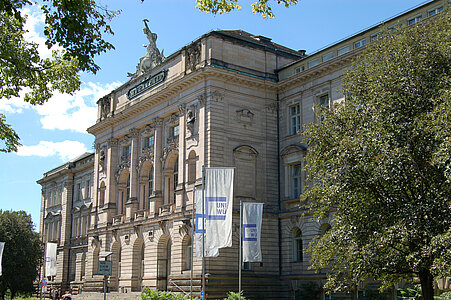Attending
Please access to the event page on Eventbrite to buy the ticket to partecipate!
The partecipation fees are summerized in the following table:
Early Registration | |
| Early Regular Registration Fee | 450€ |
| Early Student Registration Fee | 250€ |
Normal Registration | |
| Normal Regular Registration Fee | 500€ |
| Normal Student Registration Fee | 250€ |
Late Registration | |
| Late Regular Registration Fee | 550€ |
| Late Student Registration Fee | 250€ |
For both the regular and student registration, the partecipation fees include also a Banquet, everyday's lunches and tours of the University and research facilities.
For all IFAC Affiliates a 10€ discount is applied to the partecipation fees.
The IFAC CAMSAT Conference will take place at the Central Lecture Hall and Seminar building Z6 of the Julius-Maximilians-Universität in Würzburg (Bavaria, Germany). Located at the heart of the University of Würzburg's campus, the Central Lecture Hall and Seminar building offers a modern and accessible venue for academic and professional events. The building features a variety of well-equipped lecture halls and seminar rooms, each designed to enhance learning and facilitate effective communication. The largest auditorium is capable of seating hundreds of attendees, making it suitable for keynotes and large gatherings. Each space in the building is equipped with state-of-the-art audiovisual technology, ensuring a high-quality presentation experience. Additionally, the venue is fully accessible, with features in place to accommodate participants with mobility challenges. Moreover, the second floor opens to the west with a terrace. From here, one has a magnificent view of the city, the Main valley and the Marienberg Fortress.
Address
Z6-Hörsaalzentrum,
Am Hubland,
97074 Würzburg,
Germany
How to reach it
The Central Lecture Hall and Seminar building Z6 is located at the interface between Hubland-Süd campus and Hubland-Nord campus.
By plane:
- Frankfurt (FRA) and Nürnberg (NUE) are the two airports within fairly close range. There are direct train connections to Würzburg.
From Frankfurt airport the train takes about 90 minutes and departs every hour.
From Nürnberg, the train takes between 1 and 2 hours and departs almost every 30 minutes.
By train and bus:
- At Würzburg main station (ICE-, Intercity-, Interregio-Stop), the bus terminal is right in front, take the bus line 14 direction Gerbrunn.
- Train Schedule DB Bahn: www.bahn.de
- Bus Schedule Würzburger Verkehrsverbund: www.wvv.de (only in german)
By car:
- Via motorway A3
Take Exit 72 (Rottendorf) to Bundesstraße 8 towards Würzburg - exit in Gerbrunn, turn right at the traffic lights and follow the signs to "Uni Hubland". - Via motorway A7
At interchange Biebelried (A3/A7) switch to motorway A3 towards Würzburg. Then follow the signs to "Uni Hubland". - Parking: Please keep in mind that some of the parking sites are reserved for members of staff. Disabled parking is available close to the Z6-building.
Google maps directions for Central Lecture Hall and Seminar building Z6
The following, non-exclusive list provides examples of hotels in Würzburg city center or close to the Hubland Campus, from which the University Hubland Campus can be reached via a direct connection.
Hotel Würzburger Hof
A historic-style hotel in the city center, close to the main bus station.
To reach the Hubland Campus and, in particular, the Central Lecture Hall and Seminar building Z6 from the hotel, walk to the bus station "Barbarossaplatz", then take bus route 14 direction Gerbrunn from the stop “Barbarossaplatz” to the stop “Am Hubland” (tot duration: 15-20 minutes).
Hotel Alter Kranen
A hotel in the city center with a picturesque view over the river and vineyards, the old bridge and the Castle Marienberg.
To reach the Hubland Campus and, in particular, the Central Lecture Hall and Seminar building Z6 from the hotel, walk to the bus station "Barbarossaplatz", then take the bus route 14 direction Gerbrunn from the stop “Barbarossaplatz” to the stop “Am Hubland” (tot duration: 15-20 minutes). (tot duration: 20-30 minutes).
Hotel Melchior Park
A modern hotel next to Hubland Campus.
To reach the Hubland Campus and, in particular, the Central Lecture Hall and Seminar building Z6 by walking for about 10 minutes or by taking the bus route 14 direction Gerbrunn from the stop “Albert-Hoffa-Straße” to the stop “Am Hubland”. (tot duration: 10 minutes).
Würzburg is a beautifull town located by the river Main in northern Bavaria, between Frankfurt and Nuremberg. The mix of stunning historical architecture and the young population is what makes the atmosphere so unique, including 35,000 students from three different universities. The mild and sunny climate is ideal to enjoy the many activities Würzburg has to offer: visiting a beer garden next to the river, attending a sporting or cultural event or taking a stroll through one of the parks.
Over the years, Würzburg has been home to many well-known personalities. Artists whose names are inextricably linked to Würzburg are Tilman Riemenschneider and Balthasar Neumann. Wilhelm Conrad Röntgen discovered the X-rays in the local Institute of Physics. Würzburg is also the birthplace of physicist Werner Heisenberg and basketball player Dirk Nowitzki.
Würzburg is the gateway to the Romantic Road, a 350 km long route linking cultural treasures and picturesque landscapes. The Romantic Road connects the beautiful Franconian Wine Country, the world-famous fairy-tale castle Neuschwanstein, the Fugger city of Augsburg and the medieval town of Rothenburg ob der Tauber.
Some highlights we recommend for your visit:
- Visit the Residence Palace (UNESCO World Heritage Site) and the adjoining baroque Court Gardens.
- Enjoy a Brückenschoppen, a glass of Franconian wine served on the Old River Main Bridge.
- Take a trip to the Marienberg fortress for an unforgettable view of the city and its numerous churches (get further information here).
- Relax in one of Würzburg’s parks: the Ringpark which encompasses the old town like a belt, the University’s Botanical Garden, or the two former State Garden Show Areas (1990 and 2018).
- Try out Franconian delicacies (such as wine soup, bratwurst or one of the many fish specialties) in a local restaurant or café.
There is something here for everyone! For further information, please visit the website of the tourist information centre.
Other information
Available Wifi Networks: @BayernWLAN, eduroam
Currency and Banking: The official currency is Euro (€). ATMs can be found all over the city. Traveller’s checks and foreign currency can be exchanged at local banks, but please note that there are no general bank hours in Germany. Some stores and restaurants might not accept credit cards, so it is advised to ask before ordering or to bring cash.
Weather: The weather is relatively mild in September. The temperature ranges from 10 to 20 degrees Celsius (50 to 68 degrees Fahrenheit). Würzburg has less precipitation than almost any other region in Germany.
Electricity: The electrical power supply is 230 V, 50 Hz. Germany uses two plug types, C and F (Euro Plug).
Smoking: Smoking is prohibited inside public buildings, stores, restaurants and cafes.
Taxation: The value-added tax (7 - 19%) is already included in the price, the exact amount is on the receipt. Non-EU residents might get a refund for non-edible purchases.
The history of Julius-Maximilians-Universität (JMU) Würzburg reaches back as far as 1402. At that time, it was the sixth institution of higher education to be founded in the German-speaking regions of Europe, after the universities in Prague, Vienna, Heidelberg, Cologne, and Erfurt.
True to its motto ‘Science for Society’, Julius-Maximilians-Universität Würzburg (JMU) is committed to advancing research in a wide range of disciplines. Research awards and prizes confirm JMU’s place among the world’s high-performing research universities.
Renowned Scientists
Many eminent scholars and scientists, 14 Nobel Laureates among them, have conducted research and taught in Würzburg. Notable scientists include Wilhelm Conrad Röntgen, who discovered X-rays in Würzburg in 1895, and Klaus von Klitzing, who discovered the Quantum-Hall Effect. Today, Würzburg’s university comprises ten faculties with approximately 425 professors and 29,000 students.
Main Research
Comprising 10 faculties Julius-Maximilians-Universität (JMU) is big enough to offer a broad and innovative range of subjects, yet not too big to be impersonal.
-
Biology
-
Chemistry and Pharmacy
-
Human Sciences
-
Catholic Theology
-
Mathematics and Computer Science
-
Medicine
-
Arts
-
Physics and Astronomy
-
Law
-
Business Management and Economics





